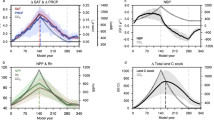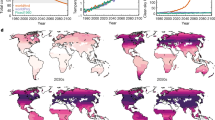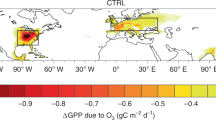Abstract
Exposure of plants to ozone inhibits photosynthesis and therefore reduces vegetation production and carbon sequestration. The reduced carbon storage would then require further reductions in fossil fuel emissions to meet a given CO2 concentration target, thereby increasing the cost of meeting the target. Simulations with the Terrestrial Ecosystem Model (TEM) for the historical period (1860–1995) show the largest damages occur in the Southeast and Midwestern regions of the United States, eastern Europe, and eastern China. The largest reductions in carbon storage for the period 1950–1995, 41%, occur in eastern Europe. Scenarios for the 21st century developed with the MIT Integrated Global Systems Model (IGSM) lead to even greater negative effects on carbon storage in the future. In some regions, current land carbon sinks become carbon sources, and this change leads to carbon sequestration decreases of up to 0.4 Pg C yr−1 due to damage in some regional ozone hot spots. With a climate policy, failing to consider the effects of ozone damage on carbon sequestration would raise the global costs over the next century of stabilizing atmospheric concentrations of CO2 equivalents at 550 ppm by 6 to 21%. Because stabilization at 550 ppm will reduce emission of other gases that cause ozone, these additional benefits are estimated to be between 5 and 25% of the cost of the climate policy. Tropospheric ozone effects on terrestrial ecosystems thus produce a surprisingly large feedback in estimating climate policy costs that, heretofore, has not been included in cost estimates.
Similar content being viewed by others
References
Adams, R. M., Hamilton, S. A., and McCarl, B. A.: 1986, ‘The benefits of pollution control: The case of ozone and U.S. Agriculture’, Am. J. Agric. Econ. 68, 886–893.
Aunan, K., Berntsen, T. K., and Seip, H. M.: 2000, ‘Surface ozone in China and its possible impact on agricultural crop yield’, Ambio 29(6), 294–301.
Babiker, M. H., Reilly, J. M., Mayer, M., Eckhaus, R. S., Wing, I. S., and Hyman, R. C.: 2001, The MIT emissions prediction and policy analysis (EPPA) model: Revisions, sensitivities, and comparisons of results, MIT Joint Program on the Science and Policy of Global Change, p. 94.
Babiker, M. H., Metcalf, G. E., and Reilly, J.: 2002, ‘Tax distortions and global climate policy’, J. Environ. Econ. Manage. 46, 269–287.
Babiker, M., Reilly, J., and Jacoby, H. 2000, ‘The Kyoto protocol and developing countries’, Energy Policy 28, 525–536.
Cros, B., Delmas, R., Nganga, D., Clairac, B., and Fontan, J.: 1988, ‘Seasonal trends of ozone in equatorial Africa: Experimental evidence of photochemical formation’, J. Geophys. Res. 93(D7), 8355–8366.
de Masin, A. V.: 2003, Economic Modeling of Urban Pollution an Climate Policy Interactions, Cambridge, MA, Massachusetts Institute of Technology.
Felzer, B. S. F., Kicklighter, D. W., Melillo, J. M., Wang, C., Zhuang, Q., and Prinn, R. G.: 2004, ‘Ozone effects on net primary production and carbon sequestration in the conterminous United States using a biogeochemistry model’, Tellus 56B, 230–248.
Gitay, H., Brown, S., Easterling, W., Jallow, B., et~al.: 2001, Ecosystems and their goods and services, Climate Change 2001: Impacts, Adaptation, and Vulnerability: Contributions of Working Group II to the Third Assessment Report of the Intergovernmental Panel on Climate Change, McCarthy, J. J., Canziani, O. F., Leary, N. A., Dokken, D. J., and White, K. S. (eds.), Cambridge University Press, New York, pp. 235–342.
Hertel, T.: 1997, Global Trade Analysis: Modeling and Applications, Cambridge University Press, Cambridge, UK.
Hjellbrekke, A. G.: 1998, Ozone Measurements.
Hjellbrekke, A. G. and Solberg, S.: 1999, Ozone Measurements.
Hyman, R. C., Reilly, J. M., Babiker, M. H., De Masin, A., and Jacoby, H. D.: 2002, ‘Modeling non-CO2 greenhouse gas abatement’, Environ. Model. Assess. 8(3), 175–186.
Jacoby, H., Eckaus, R., Ellermann, A. D., Prinn, R., Reiner, D., and Yang, Z. 1997, ‘CO2 Emissions limits: Economic adjustments and the distribution of burdens’, Energy J. 18, 31– 58.
Jacoby, H. and Sue Wing, I.: 1999, ‘Adjustment time, capital malleability, and policy cost,’ Energy J. (Special Issue), The Costs of the Kyoto Protocol: A Multi-Model Evaluation 73– 92.
Joos, F., Prentice, I. C., and House, J. I.: 2002, ‘Growth enhancement due to global atmospheric change as predicted by terrestrial ecosystem models: Consistent with U.S. forest inventory data,’ Global Change Biol. 8, 299–303.
Kamenkovich, I. V., Sokolov, A. P., and Stone, P. H.: 2002, ‘An efficient climate model with a 3D Ocean and statistical-dynamical atmosphere’, Climate Dyn. 19(7), 585–598.
Kicklighter, D. W., Bruno, M., Dönges, S., Esser, G., Heimann, M., Helfrich, J., Ift, F., Joos, F., Kaduk, J., Kohlmaier, G. H., McGuire, A. D., Melillo, J. M., Meyer, R., Moore, B., III, Nadler, A., Prentice, I. C., Sauf, W., Schloss, A. L., Sitch, S., Wittenberg, U., and Würth, G.: 1999, ‘A first-order analysis of the potential role of CO2 fertilization to affect the global carbon budget: A comparison study of four terrestrial biosphere models’, Tellus 51B, 343– 366.
Kirchoff, V. W. J. H. and Rasmussen, R. A.: 1990, ‘Time variations of CO and O3 concentrations in a region subject to biomass burning’, J. Geophys. Res. 95(D6), 7521–7532.
Krupa, S. V. and Manning, W. J.: 1988, ‘Atmospheric ozone: Formation and effects on vegetation’, Environ. Pollut. 50, 101–137.
Lawrence, M. G., Crutzen, P. J., Rasch, P. J., Eaton, B. E., and Mahowald, N. M.: 1999, ‘A model for studies of tropospheric photochemistry: Description, global distributions, and evaluation’, J. Geophys. Res. 104, 26245–26277.
Logan, J. A.: 1999, ‘An analysis of ozonesonde data for the troposphere: Recommendations for testing 3-D models and development of a gridded climatology for tropospheric ozone’, J. Geophys. Res. 104(D13), 16115–16149.
Luo, C., St. John, J. C., Xiugi, Z., Lam, K. S., Wang, T., and Chameides, W. L.: 2000, ‘A nonurban ozone air pollution episode over eastern China: Observations and model simulations’, J. Geophys. Res. 105(D2), 1889–1908.
Mahowald, N. M., Rasch, P. J., Eaton, B. E., Whittlestone, S., and Prinn, R. G.: 1997, ‘Transport of 222radon to the remote troposphere using the model of atmospheric transport and chemistry and assimilated winds from ECMWF and the National Center for Environmental Prediction/NCAR’, J. Geophys. Res. 102, 28139–28152.
Marenco, A., Gouget, H., Nedelec, P., and Pages, J.: 1994, ‘Evidence of a long-term increase in tropospheric ozone from Pic du Midi data series: Consequences: Positive radiative forcing’, J. Geophys. Res. 99(D8), 16617–16632.
Mauzerall, D. L. and Wang, X.: 2001, ‘Protecting agricultural crops from the effects of tropospheric ozone exposure: Reconciling science and standard setting in the United States, Europe, and Asia’, Annu. Rev. Energy Enivron. 26(237–268).
Mayer, M., Wang, C., Webster, M., and Prinn, R. G.: 2000a, ‘Linking local air pollution to global chemistry and climate’, J. Geophys. Res. 105(D18), 22869–22896.
Mayer, M., Hyman, R., Harnisch, J., and Reilly, J.: 2000b, ‘Emissions inventories and time trends for greenhouse gases and other pollutants, Technical Note No. 1, Joint Program on the Science and Policy of Global Change, (July) http://web.mit.edu/globalchange/www/abstracts.html#tn1.
McGuire, A. D., Sitch, S., Clein, J. S., Dargaville, R., Esser, G., Foley, J., Heimann, M., Joos, F., Kaplan, J., Kicklighter, D. W., Meier, R. A., Melillo, J. M., Moore, B., III, Prentice, I. C., Ramankutty, N., Reichenau, T., Schloss, A., Tian, H., Williams, L. J., and Wittenberg, U.: 2001, ‘Carbon balance of the terrestrial biosphere in the twentieth century: Analyses of CO2, climate and land use effects with four process-based ecosystem models’, Glob. Biogeochem. Cyc. 15(1), 183–206.
Melillo, J. M., McGuire, A. D., Kicklighter, D. W., Moore, B., III, Vorosmarty, C. J., and Schloss, A. L.: 1993, ‘Global climate change and terrestrial net primary production’, Nature 363, 234– 240.
Ollinger, S. V., Aber, J. D., and Reich, P. B.: 1997, ‘Simulating ozone effects on forest productivity: Interactions among leaf-, canopy-, and stand-level processes’, Ecol. Appl. 7(4), 1237– 1251.
Ollinger, S. V., Aber, J. D., Reich, P. B., and Freuder, R. J.: 2002, ‘Interactive effects of nitrogen deposition, tropospheric ozone, elevated CO2 and land use history on the carbon dynamics of northern hardwood forests’, Global Change Biol. 8, 545–562.
Oltmans, S. J. and Levy, H., II: 1994, ‘Surface ozone measurements from a global network’, Atmos. Environ. 28(1), 9–24.
Prinn, R., Jacoby, H., Sokolov, A., Wang, C., Xiao, X., Yang, Z., Eckhaus, R., Stone, P., Ellerman, D., Melillo, J. M., Fitzmaurice, J., Kicklighter, D. W., Holian, G., and Liu, Y.: 1999, ‘Integrated global system model for climate policy assessment: Feedbacks and sensitivity studies’, Clim. Change 41, 469–546.
Rasch, P. J., Mahowald, N. M., and Eaton, B. E.: 1997, ‘Representations of transport, convection, and the hydrologic cycle in chemical transport models: Implications for the modeling of shortlived and soluble species’, J. Geophys. Res. 102, 28127–28138.
Reich, P. B.: 1987, ‘Quantifying plant response to ozone: A unifying theory’, Tree Physiol. 3, 63– 91.
Reilly, J., Prinn, R., Harnisch, J., Fitzmaurice, J., Jacoby, H., Kicklighter, D. W., Melillo, J. M., Stone, P., Sokolov, A., and Wang, C.: 1999, ‘Multi-gas assessment of the Kyoto Protocol’, Nature 401, 549–555.
Schimel, D. S. et~al.: 2001, ‘Recent patterns and mechanisms of carbon exchange by terrestrial ecosystems’, Nature 414, 169–172.
Sokolov, A. P. and Stone, P. H.: 1998, ‘A flexible climate model for use in integrated assessments’, Clim. Dyn. 14, 291–303.
SRES: 2000, Special Report on Emissions Scenarios, Nakicenovic N., and Swart R. (eds.), World Meteorological Organization.
Tian, H., Melillo, J. M., Kicklighter, D. W., Pan, S., Liu, J., McGuire, A. D., and Moore, B., III: 2003, ‘Regional carbon dynamics in monsoon Asia and its implications for the global carbon cycle’, Global Planet. Change 37, 201–217.
Tian, H., Melillo, J. M., Kicklighter, D. W., McGuire, A. D., and Helfrich, J. V. K., III: 1999, ‘The sensitivity of terrestrial carbon storage to historical climate variability and atmospheric CO2 in the United States’, Tellus 51B, 414–452.
von Kuhlmann, R., Lawrence, M., Crutzen, P., and Rasch, P.: 2003, ‘A model for studies of tropospheric ozone and nonmethane hydrocarbons: Model description and ozone results’, J. Geophys. Res. 108, doi: 10.1029/2002JD002893.
Wang, C., Prinn, R., and Sokolov, A.: 1998, ‘A global interactive chemistry and climate model: Formulation and testing’, J. Geophys. Res. 103(D3), 3399–3417.
Wang, C. and Prinn, R. G.: 1999, ‘Impact of emissions, chemistry and climate on atmospheric carbon monoxide: 100-year predictions from a global chemistry-climate model’, Chemosphere-Global Change Sci. 1(1–3), 73–81.
Webster, M.D., Forest, C. E., Reilly, J. M., Babiker, M. H., Kicklighter, D., Mayer, M., Prinn, R., Sarofim, M. C., Sokolov, A., Stone, P., and Wang, C.: 2003, ‘Uncertainty analysis of climate change and policy response’, Clim. Change 61, 295–320.
Westenbarger, D. A., and Frisvold, G. B.: 1995, ‘Air pollution and farm level crop yields: An empirical analysis of corn and soybeans’, Agric. Resour. Econ. Rev. 24, 156–165.
Wigley, T. M. L., Richels, R., and Edmonds, J. A.: 1996, ‘Economic and environmental choices in the stabilization of atmospheric CO2 concentrations’, Nature 379(6562), 240–243.
Xiao, X., Kicklighter, D. W., Melillo, J. M., McGuire, A. D., Stone, P. H., and Sokolov, A. P.: 1997, Linking a global terrestrial biogeochemical model and a 2-dimensional climate model: Implications for the carbon budget. Tellus 49B, 18–37.
Xiao, X., Melillo, J. M., Kicklighter, D. W., McGuire, A. D., Prinn, R. G., Wang, C., Stone, P. H., and Sokolov, A.: 1998, ‘Transient climate change and net ecosystem production of the terrestrial biosphere’, Glob. Biogeochem. Cyc. 12, 345–360.
Author information
Authors and Affiliations
Corresponding author
Rights and permissions
About this article
Cite this article
Felzer, B., Reilly, J., Melillo, J. et al. Future Effects of Ozone on Carbon Sequestration and Climate Change Policy Using a Global Biogeochemical Model. Climatic Change 73, 345–373 (2005). https://doi.org/10.1007/s10584-005-6776-4
Received:
Revised:
Issue Date:
DOI: https://doi.org/10.1007/s10584-005-6776-4




